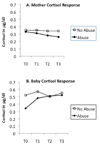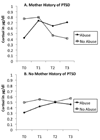The impact of maternal childhood abuse on maternal and infant HPA axis function in the postpartum period
- PMID: 19931984
- PMCID: PMC2862800
- DOI: 10.1016/j.psyneuen.2009.10.009
The impact of maternal childhood abuse on maternal and infant HPA axis function in the postpartum period
Abstract
Background: Early life trauma, particularly child abuse, has been associated with aberrations in hypothalamic-pituitary-adrenal (HPA) axis functioning in adulthood. However, the relationship of early abuse and later adult neuroendocrine changes may be moderated by additional factors such as comorbid psychopathology and recent life stress. Parental exposure to child abuse may have transgenerational effects, with offspring of abuse victims showing similar neuroendocrine profiles as their mothers. The majority of previous studies in this area focus on adult offspring, and the degree to which the effects of parental child abuse can be detected earlier in the development of the offspring remains obscure.
Methods: The current study utilized a clinical sample of women with a history of MDD (N=126), to examine the effects of maternal early life sexual and physical abuse (Childhood Trauma Questionnaire (CTQ)) on both maternal and infant salivary cortisol levels during a laboratory stress paradigm at 6 months postpartum.
Results: Maternal child abuse was associated with steeper declines in cortisol in the mothers and lower baseline cortisol in their infants. Comorbid maternal PTSD, current maternal depressive symptoms, and recent life stressors were significant moderators of maternal cortisol change. Maternal abuse history was associated with increases in cortisol levels in those mothers who experienced these additional stressors. Similarly, a history of early maternal abuse and comorbid PTSD was associated with greater increases in infant cortisol levels.
Conclusions: Maternal childhood abuse was associated with HPA axis function in both the mother and the infant during the postpartum period.
Copyright 2009 Elsevier Ltd. All rights reserved.
Conflict of interest statement
Dr. Newport has received research support from Eli Lilly, GlaxoSmithKline (GSK), Janssen, and Wyeth as well as NARSAD and NIH, and speaker’s honoraria from Astra-Zeneca, Eli Lilly, GSK, and Pfizer. Dr. Stowe has received research support from GSK, NIH, and Wyeth, served on advisory boards for Wyeth, Bristol Myers Squibb (BMS), and GSK, and received speaker’s honoraria from Eli Lilly, GSK, Pfizer, and Wyeth. Dr. Smith receives research support from the American Society for Suicide Prevention and Schering Plough Pharmaceuticals. All of the remaining authors have no past or present financial ties to for-profit enterprises.
Figures





References
-
- Ashman SB, Dawson G, Panagiotides H, Yamada E, Wilkinson CW. Stress hormone levels of children of depressed mothers. Dev. Psychopathol. 2002;14:333–349. - PubMed
-
- Beck AT, Steer RA, Brown GK. The Beck Depression Inventory. 2nd ed. San Antonio: The Psychological Corporation; 1996.
-
- Berstein D, Fink L. Childhood Trauma Questionnaire: A Retrospective Self-Report. San Antonio: The Psychological Corporation; 1998.
MeSH terms
Substances
Grants and funding
LinkOut - more resources
Full Text Sources
Medical

